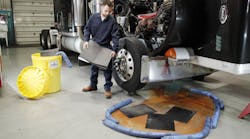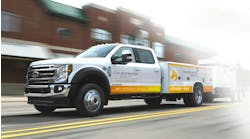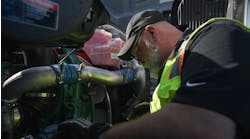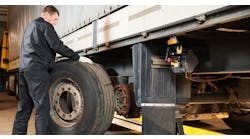Technicians know that to get the job done right, the proper tools and parts are important. But that’s only part of the equation. Knowing how to use those tools and how to diagnose problems is just as essential.
The same is true for responding to spills in your shop and yard. From a ruptured radiator to a punctured drum, having the right products and knowing how to use them will minimize costly downtime and help keep your technicians and the environment safer.
Spills interrupt the productivity of any shop. Regardless of the type of spill or the liquid spilled, when a spill happens, it needs to be dealt with before it makes an even bigger mess.
Because a wide variety of fluids, lubricants and solvents are used in vehicle maintenance shops, and because some of those fluids are hazardous, fleet maintenance facilities can be subject to a variety of U.S. EPA regulations. This means that it’s more than just a “good idea” to be ready for spills. For many facilities, it’s a legal requirement.
Since every facility is different, the EPA does not have a “master checklist” that specifies what materials are needed for spill response. Nor does the agency specify how to respond.
It is up to the facility to determine what tools and response methods will work best for their potential spill situations, and to have staff trained and prepared to use them when a spill does occur.
BROAD SELECTION
The wide variety of spill response products available today means that there are tools and equipment available to safely, efficiently and cost effectively clean up nearly any spill. The broad selection of spill response tools also means there is often more than one “right” way to handle spills.
Spill kits - These are a great way to make sure the items needed to respond to a spill are stocked in one place and ready to use. Kits can be stored in anything from a locker, to a water-tight container with pneumatic tires to wheel to the spill. They can contain anything from absorbents to vacuums - depending on what the facility responders feel will do the job the best.
Red rags may be a staple in many shops, but when it comes to spills, absorbents are faster, safer and do a much better job. Spill kits should be stocked with a variety of absorbents.
Mats - These are supplied as pads or rolls, and function like an industrial-strength paper towel. A couple of mat pads are a great choice for spills under one gallon. They’re also good as a super duty wiper, and for catching small leaks and drips during repair.
Mat rolls are superior for larger spills, for use during repairs or under leaky cores, or lining a large bench top during rebuilds.
Absorbent mats, like almost all absorbents, can be either “universal” - meaning they’ll pick up anything, or “oil-only” - meaning they’ll repel water and only absorb oil-based fluids. Oil-only mats are a great choice for fuel islands, outdoor fuel/oil transfer areas or in a wet bay because they can be used to respond to a leak or spill, rain or snow.
Universal mats are an ideal choice for indoor spill response because they’ll capture any fluid, oil- or-water-based.
A limiting factor for most mats is high-viscosity liquids, such as heavy greases or gear lubes. Because of the fluid’s high surface tension, most conventional mats will be slow to absorb these thicker liquids.
Look for universal mats that are made of 100 percent polypropylene, because polypropylene has a very broad chemical resistance. Mats that contain cellulose (such as cotton or paper) or polyester can sometimes cause a heat reaction or catch fire if they are used to absorb corrosive spills like battery acid or flammable liquids.
Some cellulose mats can also smolder if they come in contact with welding sparks or other heat sources.
Socks - These are long, tubular absorbents, roughly four or ten feet long. They are used to surround a spill and form a dike that helps prevent fluids from migrating to another area.
Like mats, socks have a variety of skins and fillers. For indoor spills, consider socks with polypropylene skins and earthen fillers, like vermiculite, to handle a wide variety of fluids.
In general, socks with granular fillers - like vermiculite and corn cob - will form a stronger dike than socks filled with fluffier materials like cotton, polypropylene or paper.
Pillows - These are used to absorb deeper spills that have been contained with socks or dikes. They’re also ideal for capturing steadier or more persistent drips - like those from fluid dispensing nozzles or pumps.
Loose absorbents - These have been around longer than mats, socks and pillows; and are available in many forms. The most common is clay.
Clay remains popular because it is inexpensive, and because it is what “has always been used.” But, like red shop towels, it is not the best product for cleaning up spills.
On average, it takes over 20 pounds of clay to clean up one gallon of spilled oil. Clay is also dusty, and that gritty dust tends to settle everywhere over time, especially on oily surfaces.
Many shops and OEMs have already banned the use of clay or “floor sweep” because of the premature wear abrasive dust can cause during rebuild operations.
Luckily, there are alternatives to clay-based loose absorbents. Ground newsprint, peat moss and corn cob are all examples of loose absorbents that are more efficient than clay-based loose absorbents and do not have abrasive dust.
STOCK CHECK
A well-stocked spill kit contains a variety of absorbents in sufficient quantities to handle the most likely spills that could occur. Some shops choose to have one large, centrally-located kit. Others choose to have multiple, smaller kits in each spill-prone area or bay.
Whichever choice is made, be sure that everyone knows where kits are stored, and that they are placed in a location or locations that can be accessed quickly and easily in the event of a spill.
It is also a good idea to have a replenishment or “stock check” plan for absorbents and spill kits.
For added safety, consider stocking personal protective equipment (PPE), such as safety glasses and gloves, with spill response supplies so workers can be properly protected when they are cleaning up spills. Material Safety Data Sheets are a good starting point to aid in the selection of PPE.
Placing PPE on top of absorbents and other items in a spill kit will help remind responders of the need for these items, and will help avoid lost time during cleanup.
GET FAMILIAR
No matter what items are chosen, take the time to train shop personnel on the use of each item before a spill happens. This allows everyone to become familiar with the products and know how they will work.
The best spill kit in the world doesn’t do anyone any good if it’s locked away in a closet or if no one knows what to do with it.
Being properly prepared to respond to spills can be the difference between a quick clean up and an all-day, messy task that no one wants to tackle. Spill kits are the tools that allow you to get everyone back to business quickly and safely.



